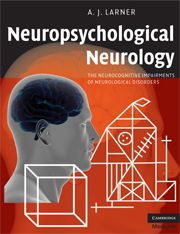Book contents
- Frontmatter
- Contents
- Acknowledgements
- Introduction
- 1 Cognitive function, neuropsychological evaluation, and syndromes of cognitive impairment
- 2 Neurodegenerative disorders
- 3 Cerebrovascular disease: vascular dementia and vascular cognitive impairment
- 4 The epilepsies
- 5 Neurogenetic disorders
- 6 Inflammatory, immune-mediated, and systemic disorders
- 7 Structural brain lesions
- 8 Endocrine, metabolic, and toxin-related disorders
- 9 Infective disorders
- 10 Neuromuscular disorders
- Index
- References
2 - Neurodegenerative disorders
Published online by Cambridge University Press: 15 December 2009
- Frontmatter
- Contents
- Acknowledgements
- Introduction
- 1 Cognitive function, neuropsychological evaluation, and syndromes of cognitive impairment
- 2 Neurodegenerative disorders
- 3 Cerebrovascular disease: vascular dementia and vascular cognitive impairment
- 4 The epilepsies
- 5 Neurogenetic disorders
- 6 Inflammatory, immune-mediated, and systemic disorders
- 7 Structural brain lesions
- 8 Endocrine, metabolic, and toxin-related disorders
- 9 Infective disorders
- 10 Neuromuscular disorders
- Index
- References
Summary
Alzheimer's disease (AD)
Alzheimer's disease (AD) is the archetypal neurodegenerative cognitive disorder (Larner, 2008). Alois Alzheimer's critical contribution, which later prompted Emil Kraepelin to bestow the eponym upon the condition, was to link the clinical phenotype of cognitive decline with specific neuropathological findings, namely neurofibrillary tangles (Hodges, 2006; Larner 2006a).
Initially conceived of as a rare disease of the presenium, it was not until the 1960s that neuropsychological (Blessed et al., 1968) and neuropathological (Tomlinson et al., 1968, 1970) studies showed that most cases of ‘senile dementia’ were identical to AD. Clinical diagnostic criteria for AD have been developed by the National Institute of Neurologic and Communicative Disorders and Stroke, and the Alzheimer's Disease and Related Disorders Association (NINCDS-ADRDA) workgroup, with definite, probable, and possible categories (McKhann et al., 1984). Clinical criteria are also available from the American Psychiatric Association's (1994) Diagnostic and Statistical Manual (DSM-IV). Generally these criteria perform well, with >80% accuracy of clinical diagnosis, hence highly sensitive for an antemortem diagnosis of AD, although specificity is poorer such that other dementias may erroneously be identified as AD. Neuropathological criteria are also available for AD, based on the quantitation and distribution of the hallmark features, senile plaques and neurofibrillary tangles (Mirra et al., 1991; Braak & Braak, 1991; National Institute on Aging, 1997).
Epidemiological studies have shown that the prevalence of AD increases steeply with increasing age, with over 50% of over-85-year-olds being affected.
- Type
- Chapter
- Information
- Neuropsychological NeurologyThe Neurocognitive Impairments of Neurological Disorders, pp. 39 - 89Publisher: Cambridge University PressPrint publication year: 2008
References
- 1
- Cited by



